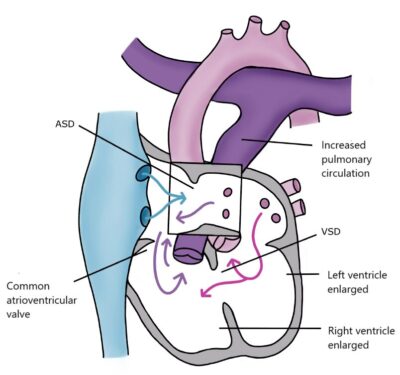Atrioventricular Septal Defect, AVSD
In complete AVSD (Atrioventricular Septal Defect), a three-dimensional part of the heart is missing. The lower part of the atrial septum and the upper part of the ventricular septum are absent, and instead of having two separate atrioventricular valves (the mitral and tricuspid valves), there is only one common atrioventricular valve between the atria and the ventricles. The atrioventricular septal defect causes heart failure within the first few weeks of life, and the resistance in the pulmonary circulation increases later. Therefore, corrective surgery is performed at the age of 4–6 months. The surgeon constructs the lower part of the atrial septum and the upper part of the ventricular septum and divides the common atrioventricular valve into two separate valves. It is generally not possible to create a well-functioning valve between the left atrium and ventricle from a severely malformed atrioventricular valve.
Incomplete AVSD is a large hole in the lower part of the atrial septum extending to the atrioventricular valves. This defect is referred to as ASD primum. The left atrioventricular valve develops from the same cells as the lower part of the atrial septum during fetal development. Therefore, in this defect, the anterior leaflet of the left atrioventricular valve is structurally abnormal and leaks.
AVSD is a common heart defect in Down syndrome. About 40% of children with Down syndrome have some form of heart defect, most commonly AVSD.
Patients require lifelong cardiac monitoring, but most do not need a second surgery or heart medication.
